This Is Why There Are So Few Black Physicists And Astronomers (And How To Fix It)
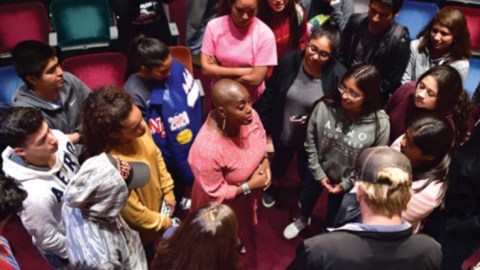
It’s not a lack of motivation, intelligence, or capability. Here’s how to open a space.
Over the past 20 years, the number of bachelor’s degrees awarded in physics has more than doubled: from just under 4,000 per year in the late 1990s to nearly 9,000 per year today, according to the most recent data. By many metrics, racial representation is on the rise as well. Black Americans earned more than twice as many STEM degrees as they did 20 years ago. But in physics, the percentage of Black Americans earning Bachelor’s degrees has plummeted over that same interval, even as Hispanic representation has nearly quadrupled.
Today, across all STEM fields, representation of Black Americans is lowest in physics and astronomy: ~3% in physics (down from more than 5% in 1999) and ~2% in astronomy. In a landmark, first-of-its-kind study, the American Institute of Physics developed a national task force to elevate the representation of Black Americans in physics and astronomy: TEAM-UP. Their full report has just been released, and it uncovers not only the causes of this under-representation, but how to fix it.

The big question that TEAM-UP sought to answer was simple:
Why are there so few black physicists and astronomers?
By assembling a team of physicists, astronomers, and education researchers, they endeavored to understand the experiences of current undergraduates, to evaluate the overall landscape of the prevailing culture in those fields in particular, and to uncover what impedes or promotes not only success in those fields, but the culture change necessary for enabling those successes. It was the first comprehensive study of Black American physics undergraduates ever undertaken.
Through surveys, interviews, site visits and more, what they concluded was as sobering as it was unsurprising. The reasons Black Americans aren’t earning Bachelor’s degrees isn’t because they’re unmotivated, uninterested, unintelligent or incapable. Instead, it’s due to elements that are prevalent in society in general and in physics and astronomy in particular.
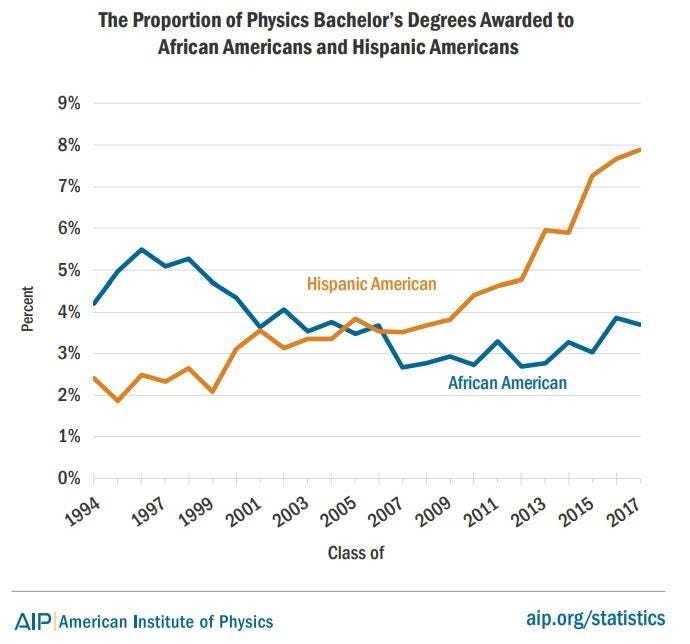
One of the most informative parts of the TEAM-UP report arose from studying specific physics departments at a number of individual colleges in detail, including colleges where the representation of Black Americans among physics and astronomy majors is exemplary. Every specific field has its own problems and cultural issues that are unique to that particular environment, and by studying just one particular field in detail, they could identify the factors that are most impactful for either nourishing or neglecting the needs of Black Americans in physics and astronomy.
The big takeaway was that there are only two main factors in determining the level of representation of Black Americans in obtaining physics and astronomy degrees:
- whether they have a supportive environment or not,
- and whether the students and the departments that support them face financial challenges or not.
Those two factors, environment and economics, are the only ones that mattered.

What makes an environment supportive or unsupportive? A few examples — some from the TEAM-UP report and some from beyond it — can help make that clear. Imagine that you’re a physics student, an undergraduate, in a classroom full of people where most of them look like one another, but not like you. Imagine that you’re working hard, you’re doing well in your classes, you’re learning new things, and you’re even beginning to do research.
If your department has the ability to be financially supportive, perhaps you’ll get the opportunity to attend a conference and present the research that you’ve been working on. Perhaps you’ll get the opportunity to meet others in your field, including peers, potential mentors, and even people whom you may end up working with down the line. But even seemingly small obstacles, particularly if they’re common to your experience and appear frequently (what are known as microaggressions), can completely undermine that sense of belonging. Here are three scenarios that illustrate how.
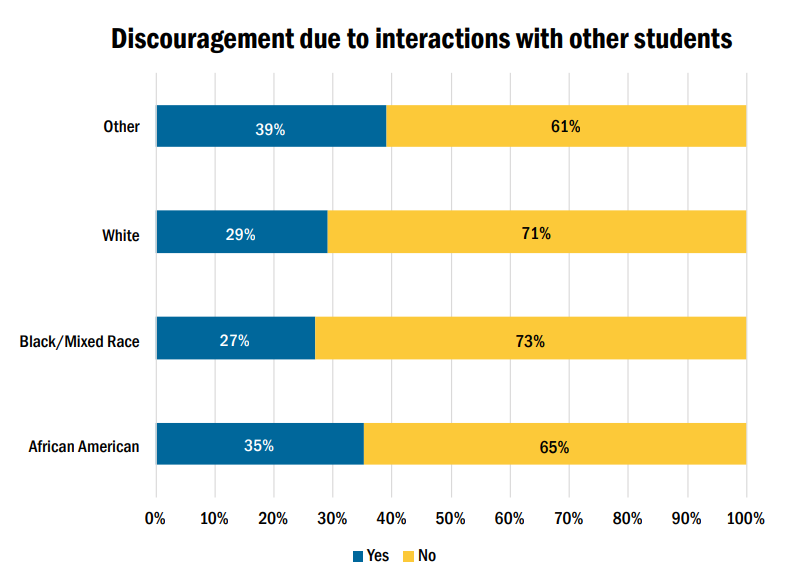
Scenario 1: You’re in class, the most advanced difficult class you’ll take this semester. The professor is solving problems on the board, and poses a question to the class. You know the answer, so you raise your hand, and the professor calls on you. You give the answer you believe to be correct, but another (white) student elsewhere in the room derisively corrects you, and nobody else in the room comes to your defense.
Scenario 2: You’re at a conference, your very first one, where you’re about to present your research alongside other scientists of all levels (students, post-docs, professors, etc.) in your specific field. As you arrive, you start looking around for anyone you recognize and come up empty. A minute later, a (white, senior) professor comes up to you with a bewildered look on his face, and asks you, “Are you the help?”
Scenario 3: You’re at a large conference, about to present your research to an audience that includes members of the press for the first time. There’s a paper and an accompanying press release to go with it, and you get a large number of questions. Over the next few days, a few stories come out in various media outlets. While most of them get the science right, one of them also includes a number of unprofessional statements with racially charged overtones, including remarks on how “articulate” you are.

I want you to think, for a minute, about what a terrible situation this is for the young aspiring physicist or astronomer, and how there’s not a way to win. If you express anger or outrage, even over what’s clearly unacceptable behavior, other people may become afraid and categorize you as a “dangerous black man” or a “ghetto black woman” in their mind. If you know your answer is correct and you dig into your position, you risk further ridicule and alienation.
If you attempt to gently correct someone who assumes that you’re an employee of the venue the conference is at, you risk them becoming defensive and deeming you a problematic person. And in the final scenario, you may even jump through all the hoops of crafting messages to the offending article’s author or their editor, only to find — even years later — that the original offensive messages are still unchanged and uncorrected. As the TEAM-UP researchers noted:
Regular exposure to unsupportive peers and faculty who make discriminatory comments, intentionally or unintentionally, will likely derail a student’s success in the field… and this is more likely for minoritized students in STEM compared with other fields.
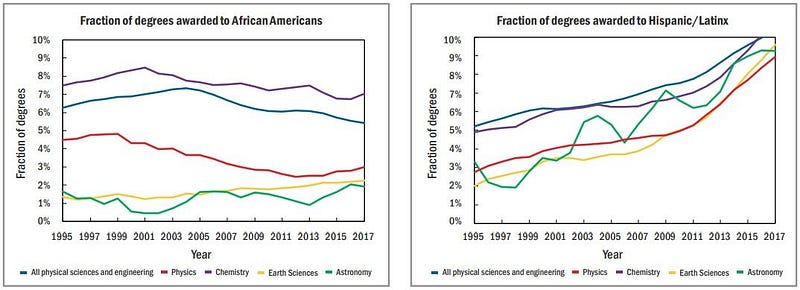
Fortunately, there is something positive and low-effort that each of us can do. Rather than view the solution as “closing a gap” between young black scientists and the rest of the field, we can think about the solution as “opening a space” for them. That means making an effort to say to them, in some way, “you have a home here,” “you are welcome here,” “your presence here is valued,” and “you are included.”
Imagine how differently the first scenario would have played out if the professor, upon hearing the white student’s remarks (which turned out to be wrong, by the way), had scolded that student for their inappropriate behavior? A counter-conversation, even after the fact, can be remarkably affirming for under-represented students. Imagine how the second scenario would have played out differently, if only the default assumption in the mind of the offending professor had been, “you belong here.”
If we can actively set up and establish better norms for what positive behaviors are, the field can become more inclusive in a long-term, sustainable manner.
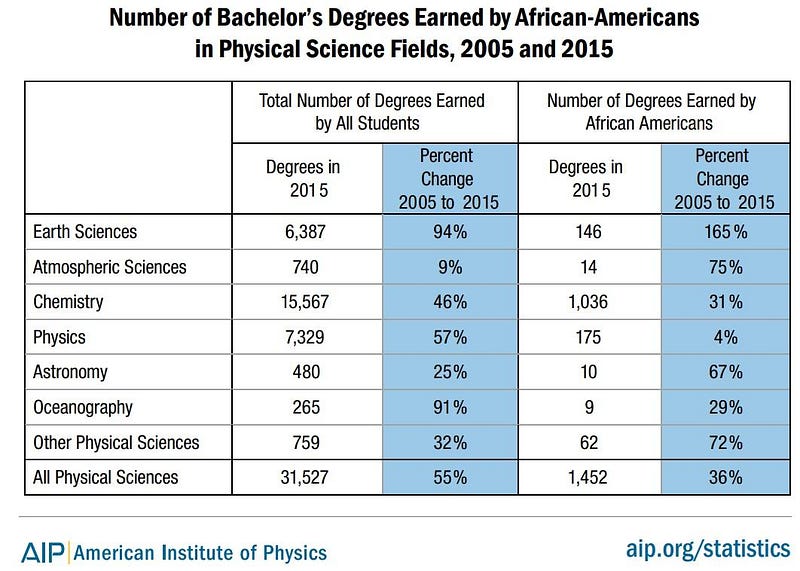
One of the simplest ways to become more inclusive is to assume, as your default, that black physicists and astronomers exist and deserve to be there. Assume that they know what they’re doing and are highly capable, but that they need support. Support on those two important fronts — of fostering an environment that supports their presence within it and in providing financial support for black students and their supporting institutions — can help change things tremendously.
And there’s a lot to combat. Compared to their white peers, black students were more likely to feel socially isolated in their physics classes or labs (49% to 34%), to feel discouraged due to interactions with other students (35% to 29%), and less likely to feel like their department created a supportive environment (74% to 85%). Perhaps most troublingly, the same percentage of black and white physics students saw others treated negatively in class because of their race or ethnicity, but black students reported experiencing that negative treatment far more frequently (32% to 11%).
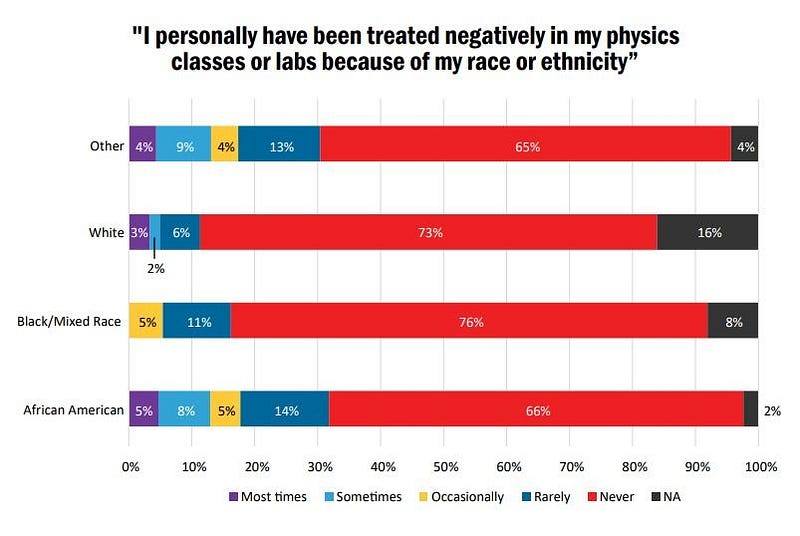
The TEAM-UP report, of course, goes much farther in making recommendations for fostering the academic and career success of black students. There are entire sections devoted on how to be a supportive, engaged faculty member or mentor, including simple actions such as reaching out to black students, following up on their progress, and making sure there are multiple people checking up on them, demonstrating their investment in that student’s success.
The report also makes specific recommendations across five key areas to support the success of black students:
- fostering a sense of belonging,
- supporting a self-perception of black students as future physicists and astronomers,
- effective teaching and a strengths-based approach to academic support,
- providing personal support to offset financial burdens and stresses,
- and having academic leaders prioritize creating supportive environments, policies, and structures.
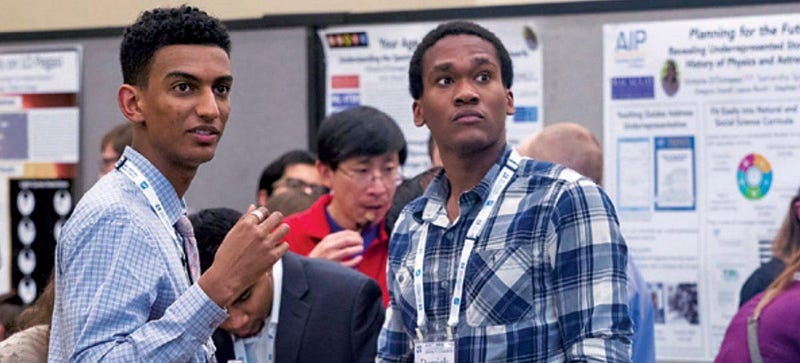
By 2030, TEAM-UP believes the number of Black Americans who get physics or astronomy degrees can be doubled versus today’s figures. In addition to the relatively small behavioral and structural recommendations that they make in their report, they stress the need for financial support as well, recommending:
A consortium of physical sciences societies should be formed to raise a $50M endowment from foundations and individuals to support minoritized students with unmet financial need in physics and astronomy and to support the implementation of this report’s recommendations by departments.
But even without donating, all of us can play an effective role in combating these structural inequalities simply by making an effort to be inclusive.
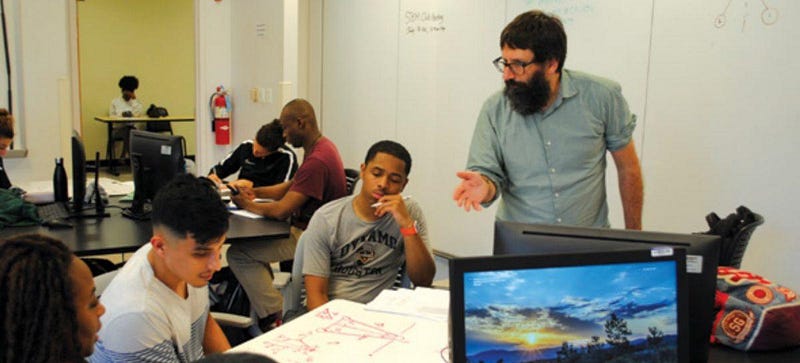
Make an effort to support black students in the classroom. Reach out to them. Invite them to study sessions. Tell them explicitly about opportunities. When you see them at a conference, introduce them to others that you know. Invite them for drinks and to social events. Send the simple message, wherever you can, that “you are welcome here” and “you belong here.”
Many of the black physicists and astronomers today were brought into the field because of positive interactions with professors and students. If we can transform the field to make that the cultural norm — and clearly, this applies to more fields than just physics and astronomy — we can better advance, serve, and promote the physical sciences for the benefit of humanity. Advancing and supporting under-represented minorities is a critical component of that, and one that we can all contribute to simply by sending that one universal message we all yearn to hear: your presence here is genuinely valued.
Ethan Siegel is the author of Beyond the Galaxy and Treknology. You can pre-order his third book, currently in development: the Encyclopaedia Cosmologica.





